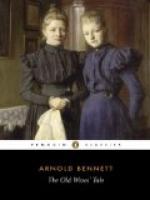This print represented fifteen sisters, all of the same height and slimness of figure, all of the same age—about twenty-five or so, and all with exactly the same haughty and bored beauty. That they were in truth sisters was clear from the facial resemblance between them; their demeanour indicated that they were princesses, offspring of some impossibly prolific king and queen. Those hands had never toiled, nor had those features ever relaxed from the smile of courts. The princesses moved in a landscape of marble steps and verandahs, with a bandstand and strange trees in the distance. One was in a riding-habit, another in evening attire, another dressed for tea, another for the theatre; another seemed to be ready to go to bed. One held a little girl by the hand; it could not have been her own little girl, for these princesses were far beyond human passions. Where had she obtained the little girl? Why was one sister going to the theatre, another to tea, another to the stable, and another to bed? Why was one in a heavy mantle, and another sheltering from the sun’s rays under a parasol? The picture was drenched in mystery, and the strangest thing about it was that all these highnesses were apparently content with the most ridiculous and out-moded fashions. Absurd hats, with veils flying behind; absurd bonnets, fitting close to the head, and spotted; absurd coiffures that nearly lay on the nape; absurd, clumsy sleeves; absurd waists, almost above the elbow’s level; absurd scolloped jackets! And the skirts! What a sight were those skirts! They were nothing but vast decorated pyramids; on the summit of each was stuck the upper half of a princess. It was astounding that princesses should consent to be so preposterous and so uncomfortable. But Sophia perceived nothing uncanny in the picture, which bore the legend: “Newest summer fashions from Paris. Gratis supplement to Myra’s Journal.” Sophia had never imagined anything more stylish, lovely, and dashing than the raiment of the fifteen princesses.
For Constance and Sophia had the disadvantage of living in the middle ages. The crinoline had not quite reached its full circumference, and the dress-improver had not even been thought of. In all the Five Towns there was not a public bath, nor a free library, nor a municipal park, nor a telephone, nor yet a board-school. People had not understood the vital necessity of going away to the seaside every year. Bishop Colenso had just staggered Christianity by his shameless notions on the Pentateuch. Half Lancashire was starving on account of the American war. Garroting was the chief amusement of the homicidal classes. Incredible as it may appear, there was nothing but a horse-tram running between Bursley and Hanbridge—and that only twice an hour; and between the other towns no stage of any kind! One went to Longshaw as one now goes to Pekin. It was an era so dark and backward that one might wonder how people could sleep in their beds at night for thinking about their sad state.




